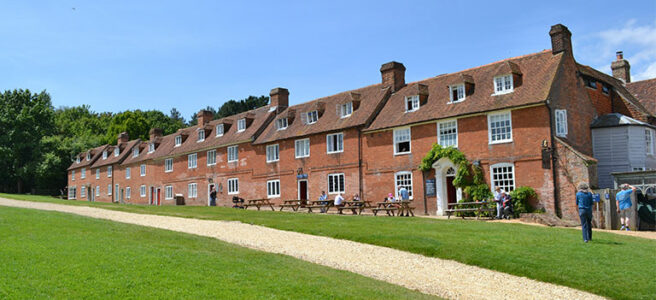Welcome back to our time traveller’s itinerary through the magical New Forest National Park!
Part 1 began in the 11th Century weaving through a tapestry of New Forest attractions, landmarks and historic houses up until the reign of Queen Elizabeth I. Now, we move on to our next stop, it is 1649, and the English Civil War has drawn to a close.
1649 (Stuart Period): Hurst Castle
View this post on Instagram
Our 17th Century stop takes us once again to one of Henry VIII’s coastal fortifications, Hurst Castle, near Milford on Sea. It was actually founded in Tudor times, but we are returning here to visit the historical site where Charles I was imprisoned shortly before his execution in 1649.
Hurst Castle is located between Lymington and Milford on Sea on the south coast of the New Forest. Resting ominously at the end of a mile-long pebble spit, the castle has stood the test of time, providing an excellent defensive position that remained functional throughout the Second World War.
Hurst Castle has been home to several prisoners, but none so famous than our own King, Charles I. It was here that Charles found himself temporarily imprisoned as he awaited his forthcoming execution for treason. As you stand on the windswept pebble spit you can imagine the sorry spectacle of King Charles I, shuffling out of the castle gate toward his infamous rendezvous with the executioner.
Today Hurst Castle is home to several exhibits, with a tearoom providing welcome refreshments. If you don’t fancy the walk along the spit, nearby boat trips from the quaint fishing hamlet of Keyhaven can drop you right outside the castle’s front entrance.
Find New Forest Cottages in Milford on Sea
1777 (Georgian Period): Bucklers Hard
View this post on Instagram
To immerse yourself in 18th century maritime life, there is no better New Forest attraction than Bucklers Hard, a small and picturesque hamlet situated on the Beaulieu River.
Picture the year 1777 when Bucklers Hard was home to a thriving shipbuilding community. Ahead of you on the water’s edge is the magnificent HMS Agamemnon during its early stage of production. It is a fine ship that would one day serve under Nelson’s command and form part of the British flotilla at the battle of Trafalgar.
You can imagine the shipwrights and labourers skilfully crafting the massive oak timbers that have been felled from the nearby New Forest woodland. You don’t need to do much imagining at Bucklers Hard, as the village remains unchanged from this bygone era. The shipbuilding activity may be gone, but the quaint rows of ship builder’s cottages remain beautifully preserved.
A trip to Bucklers Hard is a must for the history buff, or for those who just want to soak up the romantic charm of this unspoilt hamlet. The full story of Bucklers Hard can be explored in the Bucklers Hard Maritime Museum, with additional live historical events available throughout the year.
Find New Forest Cottages near Bucklers Hard
1914-1917 (The Great War): The Portuguese Fireplace
View this post on Instagram
It is 1917, storm clouds rage over Europe, and many New Forest men are away fighting for our liberty on the continent. Back at home, it is essential that the war effort is supported through a plentiful supply of timber from the New Forest. With much of our own labour depleted, essential support was provided by a Portuguese army unit, who set up camp at a site close to Emery Down, near Lyndhurst in the New Forest.
This site, which was managed by the Canadian military, once spanned 5 acres and comprised 25 huts, a cookhouse, shops and hospital. Today all that remains of the site is a solitary fireplace from the cookhouse, left as a fitting memorial to the industrious efforts of this small community.
It is a humble and sombre reminder of the important role the New Forest played in supporting the war effort. Take a moment to imagine this once bustling industrious settlement – although it may be quite difficult when all there is to hear is the sound of the birds.
Find New Forest Cottages in Lyndhurst
1939-1945 (The Second World War): Lepe Beach
View this post on Instagram
It is 1944 and we are on the coastline close to Lepe Beach, the air throngs with the sound of shouted orders and boots on concrete; we are in the midst of D-Day preparations.
Lepe Beach played an important role in preparing troops and craft in readiness for the D-Day invasions. Today the foundations of many of the original structures can still be seen, including the base of the water tower, loading ramps and jetties. The primary purpose of the site was to create large caissons (bridge supports) that would be used in the construction of build Mulberry harbours. These temporary harbours provided essential platforms for the unloading of cargo during the D-Day landings. The shoreline is also scattered with concrete mats, with a strange ‘chocolate bar’ style appearance, which provided a firm ground from which tanks and troops could easily embark and disembark from the landing vessels.
Lepe Beach forms part of the Lepe Country Park, situated on the south-eastern corner of the New Forest. Located between Exbury Gardens and Calshot, Lepe is now a tranquil coastal destination overlooking the Isle of Wight and the shipping lanes of the Solent. It’s a lovely day out for picnics, ball games and walks.
Find New Forest Cottages in Exbury
The late 20th Century: Beaulieu National Motor Museum
View this post on Instagram
For our last stop, we are going to take a look at British motoring heritage with a trip to the world-famous Beaulieu National Motor Museum.
Located 7 miles south-west of Lyndhurst, the National Motor museum sits on the outskirts of the delightful historic and pretty village of Beaulieu. It is a fitting location with which to finish our journey through history and is a popular destination for visitors to the New Forest.
The museum is home to over 280 vehicles spanning over a century of motoring history and is packed full of permanent attractions, as well as a host of temporary themed exhibitions. Whether you want to reminisce seeing cars from film and TV, show little ones your old car, or imagine motoring life in bygone years, Beaulieu has something for the whole family.
When combined with the aforementioned Beaulieu Abbey and the 16th Century Palace House, the National Motor Museum provides a trio of historical attractions.
Find New Forest Cottages in Beaulieu
And so our journey through history comes to a close, and once again the New Forest demonstrates why it is such a popular, year-round holiday destination for everyone. So if you can tear yourself away from the breathtaking countryside and beautiful coastline during your holiday, why not spare some time for a trip through time.
Take a look at our full portfolio of over 140 New Forest Cottages

